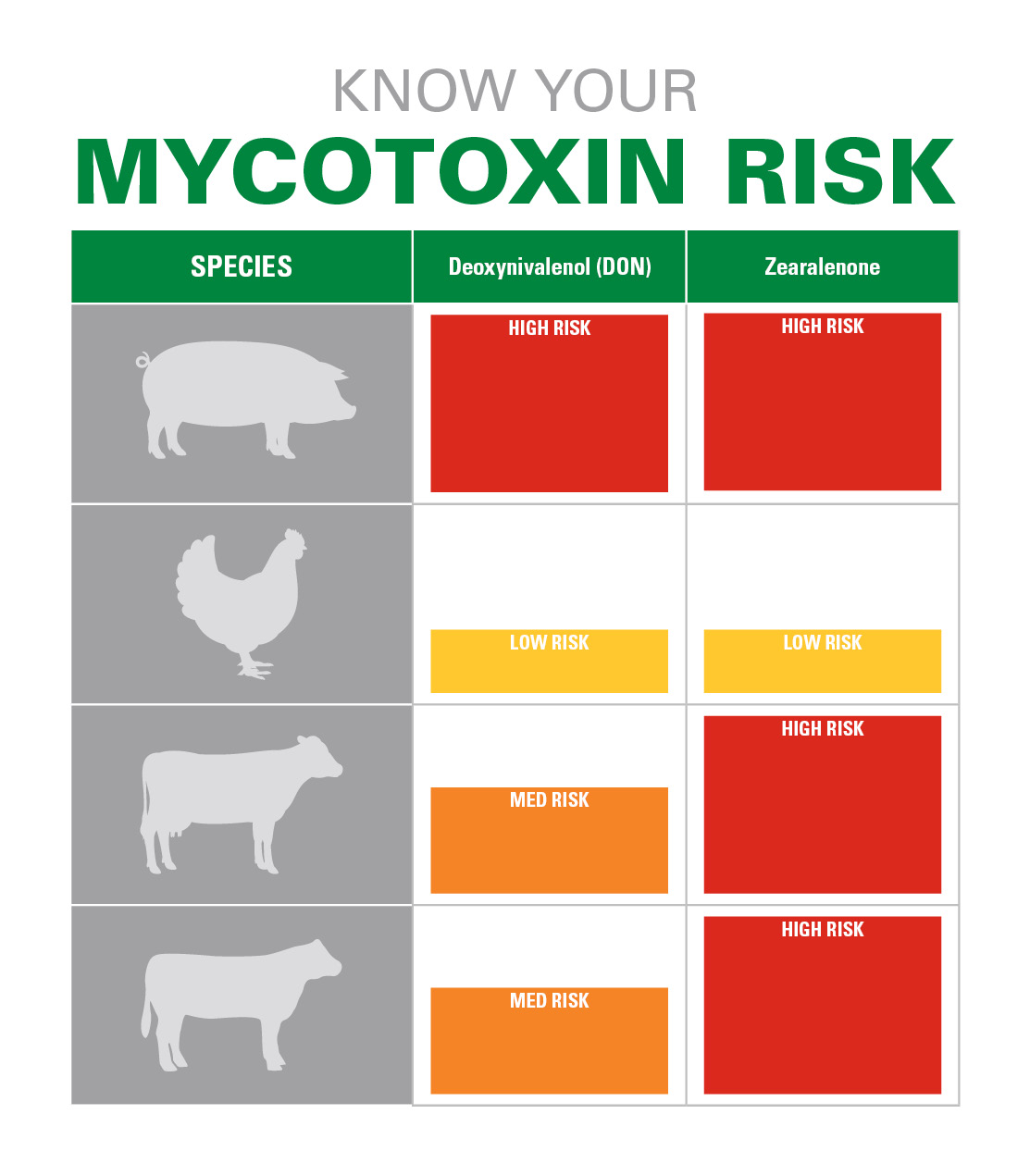Another trend in the 2020/2021 corn crop is increased prevalence of deoxynivalenol (DON) and zearalenone, observed in 73% and 64% of corn samples, respectively. Worse yet, levels of these two toxins were nearly 2X greater than the 2019/2020 corn crop, averaging 2.68 ppm DON and 248 ppb zearalenone.1
With mycotoxin co-contamination, DON and zearalenone levels on the rise, let’s take a closer look at the potential impact these trends pose to animal health and performance.
Deoxynivalenol
DON, also known as vomitoxin, is produced by Fusarium molds and causes major declines in feed intake and efficiency in infected animals. In general, the risk of DON infection is greatest in hogs; whereas, poultry and cattle tend to have higher tolerance for this mycotoxin.DON is rapidly absorbed in pigs and inflicts gastrointestinal system damage through the breakdown of tight junction proteins between epithelial cells in the gut lining.2 This intestinal barrier breakdown leads to decreased nutrient absorption and enables harmful bacteria, toxins and pathogens to enter the body’s other internal systems. DON ingestion – even at low levels – can also modulate immune responsiveness of the intestinal mucosa, thereby limiting livestock and poultry’s ability to respond to stress and disease.
Because DON is known to have potential severe consequences to animal health and performance, the U.S. Food and Drug Administration (FDA) has issued guidance regarding advisory levels for DON levels for grains and grain by-products used for animal feed. FDA advisory levels for grain begin with 1 ppm in the total ration for swine, 5 ppm for chickens and 5 ppm for dairy cattle. Consult the FDA website for more information on the advisory levels for DON.3
Zearalenone
Zearalenone is an estrogenic Fusarium mycotoxin, which binds to the same receptors as the natural hormone estrogen. This causes increased estrogenic activity that can adversely affect reproduction through symptoms such as lowered embryo survival, increased infertility, increased abortion in pregnant sows and dairy cattle, as well as reduced hatchability and declined egg production in layers. Zearalenone, and its derivatives, can also impair inflammatory responses and may negatively influence morphology of the large intestine.2
Cattle are typically less adversely affected by zearalenone due to the presence of other bacteria in the rumen that prevent the toxin from reaching lower portions of the gut. The FDA has not established specific advisory levels for zearalenone, but general guidance levels in feed begin at < 0.5 ppm for swine, < 1 ppm for poultry and 20 ppm for mature cows, albeit > 10 ppm may cause reproductive dysfunction in heifers.4,5,6
DON + Zearalenone
Since Fusarium molds produce multiple mycotoxins under the same environmental conditions, concurrent contamination of grains with DON and zearalenone is common. The problem is the toxicity of mycotoxin combinations cannot always be predicted based upon their individual toxicities. For example, recent research indicates combinations of low levels of DON and zearalenone can become a much bigger issue than having high levels of zearalenone by itself.2,7,8
Synergistic negative effects of DON and zearalenone are tied to each toxin’s unique mode of action. DON negatively impacts the gut lining, so tight junctions loosen, making it easier for contaminants (like zearalenone) to enter the bloodstream. Layering zearalenone on top of poor intestinal integrity caused by DON can quickly lead to false heats, abortions and reproductive issues. Overall, the negative effect of DON on the intestinal barrier winds up exacerbating the issues with zearalenone because they’re happening at the same time.
Summary
As producers fine-tune their mycotoxin management strategies, understanding the potential impact of mycotoxin trends on animal health and performance is key. To date, two major trends in the 2020/2021 corn crop have been observed by Kemin CLS:
- Mycotoxin co-contamination is the rule not the exception.
- DON and zearalenone are prevalent and their levels are on the rise versus prior year.
Implementation of a comprehensive mycotoxin testing program for incoming grains at the feed mill can help identify mycotoxin risks, like those observed by Kemin CLS, in ingredients before manufacturing feeds. Furthermore, inclusion of mold inhibitors, to control mold growth, as well as use of flow agents to neutralize toxins in diets can help producers minimize the impacts of mycotoxins on animal health and performance.9,10
For more information about solutions to address the risk of mycotoxins in your operation please visit kemin.com/kallsil.
References
1Data from Kemin CLS corn samples submitted as part of an annual monitoring program.
2Przybylska-Gornowicz, B. et al. 2018. The effects of deoxynivalenol and zearalenone on the pig large intestine. A light and electron microscopy study. Toxins, 10(4):148-165.
3Guidance for Industry and FDA: Advisory Levels for Deoxynivalenol (DON) in Finished Wheat Products for Human Consumption and Grains and Grain By-Products used for Animal Feed. https://www.fda.gov/regulatory-information/search-fda-guidance-documents/guidance-industry-and-fda-advisory-levels-deoxynivalenol-don-finished-wheat-products-human, accessed May 14, 2021.
4CVM Annual Report on Mycotoxins in Animal Food Report for Fiscal Year 2016 (FY16). https://www.fda.gov/media/130526/download, accessed May 18, 2021.
5Menegat, M. B., Goodband, R. D., DeRouchey, J. M., Tokach, M. D., Woodworth, J. C., and Dritz, S. S. 2019. Kansas State University Swine Nutrition Guide: Mycotoxins in Swine Diets.
6Merck Veterinary Manual. 2018. Estrogenism and Vulvovaginities. Accessed May 18, 2021. https://www.merckvetmanual.com/toxicology/mycotoxicoses/estrogenism-and-vulvovaginitis,
7Kouadio, J.H. et al. 2007. Effects of combinations of Fusarium mycotoxins on the inhibition of macromolecular synthesis, malondialdehyde levels, DNA methylation and fragmentation, and viability in Caco-2 cells. Toxins, 49(3):306-317.
8Smith, M.C. et al. 2016. Natural Co-Occurrence of mycotoxins in foods and feeds and their in vitro combined toxicological effects. Toxins, 8(4):94, doi:10.3390/toxins8040094.
9Ramos, A.J., J. Fink-Gremmels, and E. Hernández. (1996). Prevention of toxic effects of mycotoxins by means of nonnutritive adsorbent compounds. J. Food Protection, 59(6):631-641.
10Vila-Donat, P., S. Marín, V. Sanchis, and A. J. Ramos. (2018). A review of the mycotoxin adsorbing agents, with an emphasis on their multi-binding capacity, for animal feed decontamination. Food and Chemical Toxicology, 114:246-259.


